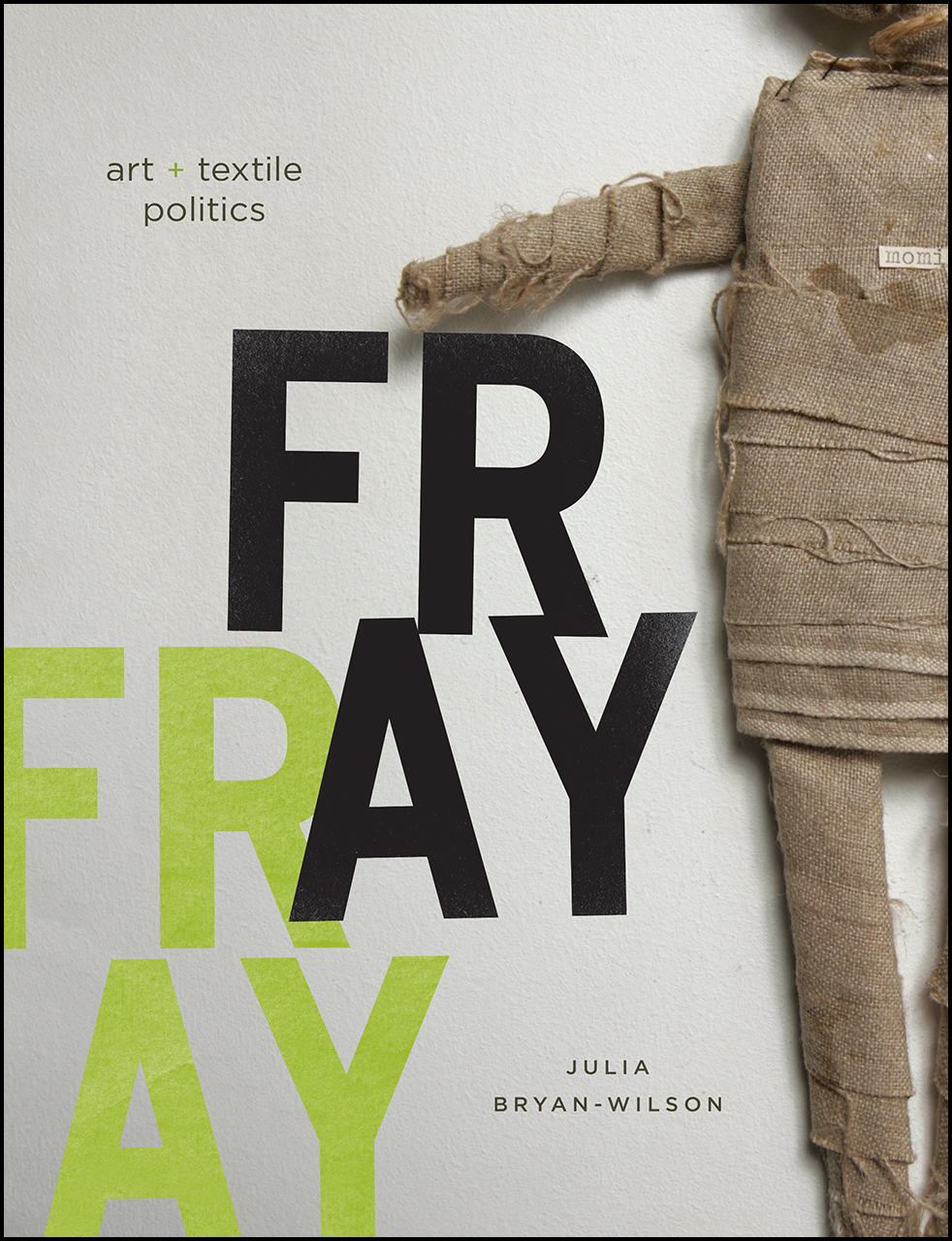Julia Bryan-Wilson: Fray: Art and Textile Politics (2017)
Filed under book | Tags: · activism, aids, art, art criticism, art history, craft, feminism, fiberwork, folk art, gender, handmaking, labour, politics, queer, quilting, race, textile, textile design, weaving

“In 1974, women in a feminist consciousness-raising group in Eugene, Oregon, formed a mock organization called the Ladies Sewing Circle and Terrorist Society. Emblazoning its logo onto t-shirts, the group wryly envisioned female collective textile making as a practice that could upend conventions, threaten state structures, and wreak political havoc. Elaborating on this example as a prehistory to the more recent phenomenon of “craftivism”—the politics and social practices associated with handmaking—Fray explores textiles and their role at the forefront of debates about process, materiality, gender, and race in times of economic upheaval.
Closely examining how amateurs and fine artists in the United States and Chile turned to sewing, braiding, knotting, and quilting amid the rise of global manufacturing, Julia Bryan-Wilson argues that textiles unravel the high/low divide and urges us to think flexibly about what the politics of textiles might be. Her case studies from the 1970s through the 1990s—including the improvised costumes of the theater troupe the Cockettes, the braided rag rugs of US artist Harmony Hammond, the thread-based sculptures of Chilean artist Cecilia Vicuña, the small hand-sewn tapestries depicting Pinochet’s torture, and the NAMES Project AIDS Memorial Quilt—are often taken as evidence of the inherently progressive nature of handcrafted textiles. Fray, however, shows that such methods are recruited to often ambivalent ends, leaving textiles very much “in the fray” of debates about feminized labor, protest cultures, and queer identities; the malleability of cloth and fiber means that textiles can be activated, or stretched, in many ideological directions.
The first contemporary art history book to discuss both fine art and amateur registers of handmaking at such an expansive scale, Fray unveils crucial insights into how textiles inhabit the broad space between artistic and political poles—high and low, untrained and highly skilled, conformist and disobedient, craft and art.”
Publisher University of Chicago Press, 2017
ISBN 9780226077819, 0226077810
326 pages
via slowrotation
Reviews: Holland Cotter (New York Times, 2017), Barbara Wisnoski (J Canadian Art History, 2018), Alexa Griffith Winton (J Design History, 2019), Janis Jefferies (Art Bulletin, 2019), Elizabeth S. Hawley (Winterthur Portfolio, 2019), Jayme Collins (InVisible Culture, 2019), Jason Edwards (Sculpture J, 2019), Katarzyna Falęcka (J Visual Culture, 2021).
Video interview with author (with Lynne Cooke, NGA, 60 min, 2017)
PDF (18 MB)
Comment (0)Compagnie de l’Art Brut: L’art brut préféré aux arts culturels (1949) [FR, EN]
Filed under catalogue | Tags: · art, art brut, folk art, naive art, outsider art

Catalogue of the exhibition inaugurating art brut.
“Jean Dubuffet’s strong anti-cultural positions have led him to be interested and to seek new forms of art, far from any official production. The term Art Brut appears in 1945, when Jean Dubuffet made his first trips to research marginal art work in Switzerland and in France. Two years later, the art dealer René Drouin makes available the basement of his gallery, Place Vendôme in Paris, which became the Foyer de l’Art Brut. Inaugurated with the Barbus Müller, it welcomed exhibitions devoted to Wölfli, Crépin, Aloïse, Salingardes, Forestier, Juva and Hernandez.
In autumn of 1948, the Foyer de l’Art Brut is transfered to a house rented by the editor Gaston Gallimard and became the Compagnie de l’Art Brut. The founding members included Jean Dubuffet, André Breton, Jean Paulhan, Charles Ratton, Henri-Pierre Roché, Michel Tapié and Edmond Bomsel. The artist Slavko Kopač assumed the role of curator of the collection.
In October 1949, the Galerie René Drouin exhibits 200 works by 60 different authors. The text of the catalogue, entitled L’Art Brut préféré aux arts culturels [Crude Art Preferred to Cultural Art], written by Jean Dubuffet, defines the concept of Art Brut:
‘By this we mean the works executed by people free artistic culture, where mimicry, contrary to what happens among intellectuals, has little or no part, so that their authors draw all (subjects, choice of the used materials, means of transposition, rhythms, ways of writing, etc.) of their own heart and not clichés of classical art or fashionable art. We assist them in all pure artistic operation, raw, reinvented in the whole of all its phases by its author, from only his own impulses. Art so that the only function of the invention is manifested, and not those, constants in cultural art, chameleon and monkey.'” (Source)
Publisher René Drouin, Paris, October 1949
[52] pages, 20 x 17 cm
via Beinecke Rare Book & Manuscript Library
JPGs
PDF (40 MB)
English translation of Dubuffet’s preface
See also Art Brut Lausanne Collection online
Comment (0)
